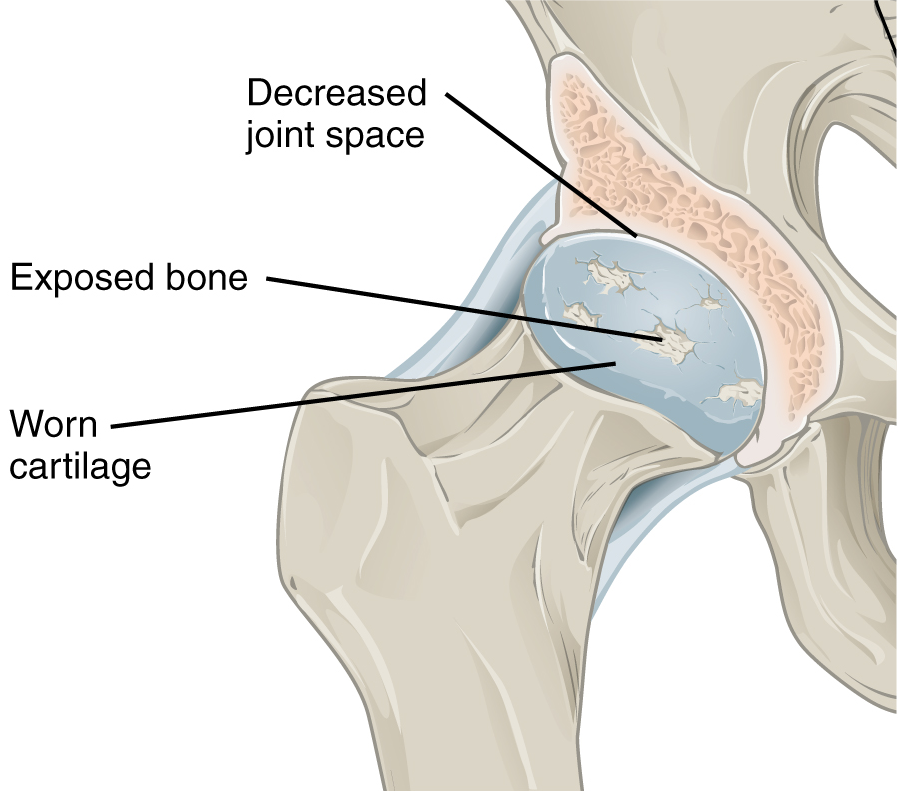Hip Osteoarthritis: Difference between revisions
No edit summary |
No edit summary |
||
| Line 1: | Line 1: | ||
{{stub}} | {{stub}} | ||
{{condition | |||
|image=Hip osteoarthritis illustration.png | |||
|name= | |||
|taxonomy= | |||
|synonym= | |||
|definition= | |||
|epidemiology= | |||
|causes= | |||
|pathophysiology= | |||
|classification= | |||
|primaryprevention= | |||
|secondaryprevention= | |||
|riskfactors= | |||
|clinicalfeatures= | |||
|history= | |||
|examination= | |||
|diagnosis= | |||
|tests= | |||
|ddx= | |||
|treatment= | |||
|prognosis= | |||
}} | |||
==Epidemiology== | ==Epidemiology== | ||
The prevalence of radiographic hip osteoarthritis is 18.2% in men and 14.3% in women<ref>{{#pmid:26241774}}</ref> | The prevalence of radiographic hip osteoarthritis is 18.2% in men and 14.3% in women<ref>{{#pmid:26241774}}</ref> | ||
| Line 8: | Line 30: | ||
==Clinical Features== | ==Clinical Features== | ||
===History=== | |||
The pain is often poorly localised. Patients can have pain over quite a large area including the front of the thighs, groin, lateral thighs, buttocks, and the posterior upper thighs. Patients with [[Central Sensitisation]] can have unusual distributions of pain at a surprising distance from the hip such as below the knee. | |||
There is no clear association between pain levels and radiographic severity of hip osteoarthritis. Up to 40% of patients with hip osteoarthritis have no pain. Patients with higher pain levels showed differences in sensitisation as measured by quantitative sensory testing.<ref name="hattori">Hattori T, Shimo K, Niwa Y, Tokiwa Y, Matsubara T. Association of Chronic Pain with Radiologic Severity and Central Sensitization in Hip Osteoarthritis Patients. J Pain Res. 2021;14:1153-1160 [https://doi.org/10.2147/JPR.S296273 DOI]</ref> | There is no clear association between pain levels and radiographic severity of hip osteoarthritis. Up to 40% of patients with hip osteoarthritis have no pain. Patients with higher pain levels showed differences in sensitisation as measured by quantitative sensory testing.<ref name="hattori">Hattori T, Shimo K, Niwa Y, Tokiwa Y, Matsubara T. Association of Chronic Pain with Radiologic Severity and Central Sensitization in Hip Osteoarthritis Patients. J Pain Res. 2021;14:1153-1160 [https://doi.org/10.2147/JPR.S296273 DOI]</ref> | ||
===Examination=== | |||
{{Main|Hip Examination}} | |||
==Prognosis== | ==Prognosis== | ||
| Line 26: | Line 53: | ||
[[Category:Hip Joint]] | [[Category:Hip Joint]] | ||
[[Category:Osteoarthritis]] | [[Category:Osteoarthritis]] | ||
Revision as of 12:11, 20 June 2021

| |
| Hip Osteoarthritis |
|---|
Epidemiology
The prevalence of radiographic hip osteoarthritis is 18.2% in men and 14.3% in women[1]
Aetiopathogenesis
- Higher bone density can drive knee osteoarthritis but not hip osteoarthritis
Clinical Features
History
The pain is often poorly localised. Patients can have pain over quite a large area including the front of the thighs, groin, lateral thighs, buttocks, and the posterior upper thighs. Patients with Central Sensitisation can have unusual distributions of pain at a surprising distance from the hip such as below the knee.
There is no clear association between pain levels and radiographic severity of hip osteoarthritis. Up to 40% of patients with hip osteoarthritis have no pain. Patients with higher pain levels showed differences in sensitisation as measured by quantitative sensory testing.[2]
Examination
- Main article: Hip Examination
Prognosis
- A minority have clear cut clinical and radiological recovery, especially with marked osteophytosis and concentric disease
- Superolateral migration of the femoral head is correlated with more rapid osteoarthritis progression, also with atrophic bone response
Treatment
Total hip joint replacement is usually effective for reducing pain. However 10% of patients have chronic postsurgical pain, and preoperative central sensitisation has been thought to be a risk factor for this.[2]
Resources
- Dieppe PA good author to read
References
- ↑ Iidaka et al.. Prevalence of radiographic hip osteoarthritis and its association with hip pain in Japanese men and women: the ROAD study. Osteoarthritis and cartilage 2016. 24:117-23. PMID: 26241774. DOI.
- ↑ 2.0 2.1 Hattori T, Shimo K, Niwa Y, Tokiwa Y, Matsubara T. Association of Chronic Pain with Radiologic Severity and Central Sensitization in Hip Osteoarthritis Patients. J Pain Res. 2021;14:1153-1160 DOI
Literature Review
- Reviews from the last 7 years: review articles, free review articles, systematic reviews, meta-analyses, NCBI Bookshelf
- Articles from all years: PubMed search, Google Scholar search.
- TRIP Database: clinical publications about evidence-based medicine.
- Other Wikis: Radiopaedia, Wikipedia Search, Wikipedia I Feel Lucky, Orthobullets,


